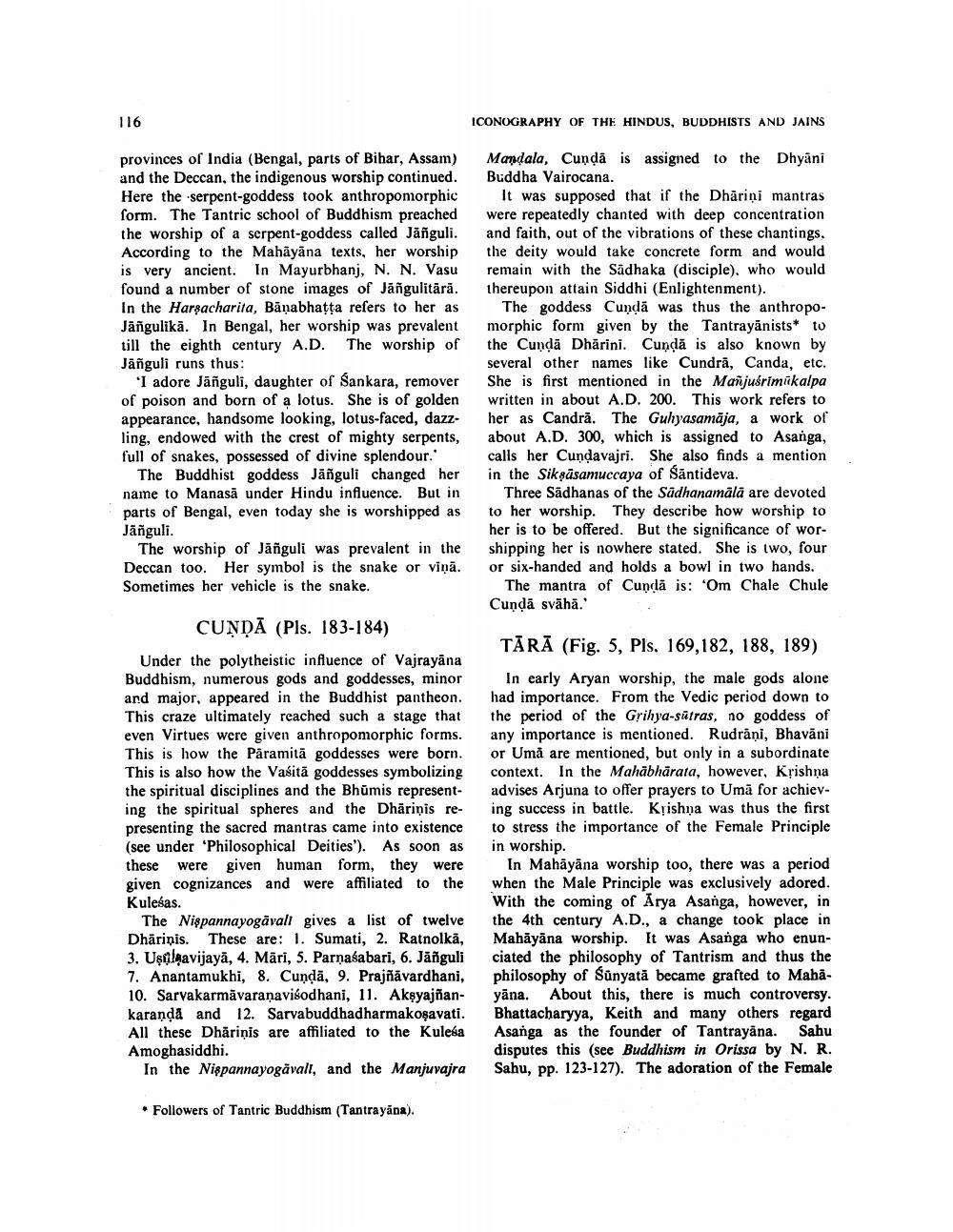________________
116
ICONOGRAPHY OF THE HINDUS, BUDDHISTS AND JAINS
provinces of India (Bengal, parts of Bihar, Assam) and the Deccan, the indigenous worship continued. Here the serpent-goddess took anthropomorphic form. The Tantric school of Buddhism preached the worship of a serpent-goddess called Jänguli. According to the Mahāyāna texts, her worship is very ancient. In Mayurbhanj, N. N. Vasu found a number of stone images of Jāñgulitārā. In the Harşacharita, Bāṇabhatta refers to her as Jāngulikā. In Bengal, her worship was prevalent till the eighth century A.D. The worship of Jáñguli runs thus:
'I adore Jānguli, daughter of Sankara, remover of poison and born of a lotus. She is of golden appearance, handsome looking, lotus-faced, dazzling, endowed with the crest of mighty serpents, full of snakes, possessed of divine splendour.
The Buddhist goddess Jāñguli changed her name to Manasā under Hindu influence. But in parts of Bengal, even today she is worshipped as Jānguli.
The worship of Jänguli was prevalent in the Deccan too. Her symbol is the snake or viņā. Sometimes her vehicle is the snake.
Mandala, Cunda is assigned to the Dhyani Buddha Vairocana.
It was supposed that if the Dhāriņi mantras were repeatedly chanted with deep concentration and faith, out of the vibrations of these chantings. the deity would take concrete form and would remain with the Sadhaka (disciple), who would thereupon attain Siddhi (Enlightenment).
The goddess Cundā was thus the anthropomorphic form given by the Tantrayānists* to the Cunda Dharini. Cunda is also known by several other names like Cundrā, Canda, etc. She is first mentioned in the Manjusrimakalpa written in about A.D. 200. This work refers to her as Candra. The Gulyasamāja, a work of about A.D. 300, which is assigned to Asanga, calls her Cundavajri. She also finds a mention in the Sikşāsamuccaya of Săntideva.
Three Sadhanas of the Sâdhanamala are devoted to her worship. They describe how worship to her is to be offered. But the significance of worshipping her is nowhere stated. She is two, four or six-handed and holds a bowl in two hands.
The mantra of Cundā is: 'Om Chale Chule Cundā svāhā."
CUNDĀ (Pls. 183-184)
Under the polytheistic influence of Vajrayāna Buddhism, numerous gods and goddesses, minor and major, appeared in the Buddhist pantheon. This craze ultimately reached such a stage that even Virtues were given anthropomorphic forms. This is how the Paramitā goddesses were born. This is also how the Vasitā goddesses symbolizing the spiritual disciplines and the Bhūmis representing the spiritual spheres and the Dhāriņis re- presenting the sacred mantras came into existence (see under 'Philosophical Deities'). As soon as these were given human form, they were given cognizances and were affiliated to the Kulešas.
The Nigpannayogāvali gives a list of twelve Dhāriņis. These are: 1. Sumati, 2. Ratnolkā, 3. Usulaavijayā, 4. Māri, 5. Parnasabari, 6. Jānguli 7. Anantamukhi, 8. Cundā, 9. Prajñāvardhani, 10. Sarvakarmāvaranaviśodhani, 11. Akşyajñankarandi and 12. Sarvabuddhadharmakogavati. All these Dhāriņis are affiliated to the Kulesa Amoghasiddhi.
In the Nigpannayogāvall, and the Manjuvajra
TĀRĀ (Fig. 5, Pls. 169,182, 188, 189)
In early Aryan worship, the male gods alone had importance. From the Vedic period down to the period of the Grihya-sūtras, no goddess of any importance is mentioned. Rudrāni, Bhavāni or Umă are mentioned, but only in a subordinate context. In the Mahābhārata, however, Krishna advises Arjuna to offer prayers to Umā for achieving success in battle. Kyishma was thus the first to stress the importance of the Female Principle in worship.
In Mahāyāna worship too, there was a period when the Male Principle was exclusively adored. With the coming of Arya Asanga, however, in the 4th century A.D., a change took place in Mahāyāna worship. It was Asanga who enunciated the philosophy of Tantrism and thus the philosophy of Sunyată became grafted to Mahayāna. About this, there is much controversy. Bhattacharyya, Keith and many others regard Asanga as the founder of Tantrayāna. Sahu disputes this (see Buddhism in Orissa by N. R. Sahu, pp. 123-127). The adoration of the Female
• Followers of Tantric Buddhism (Tantrayāna).




